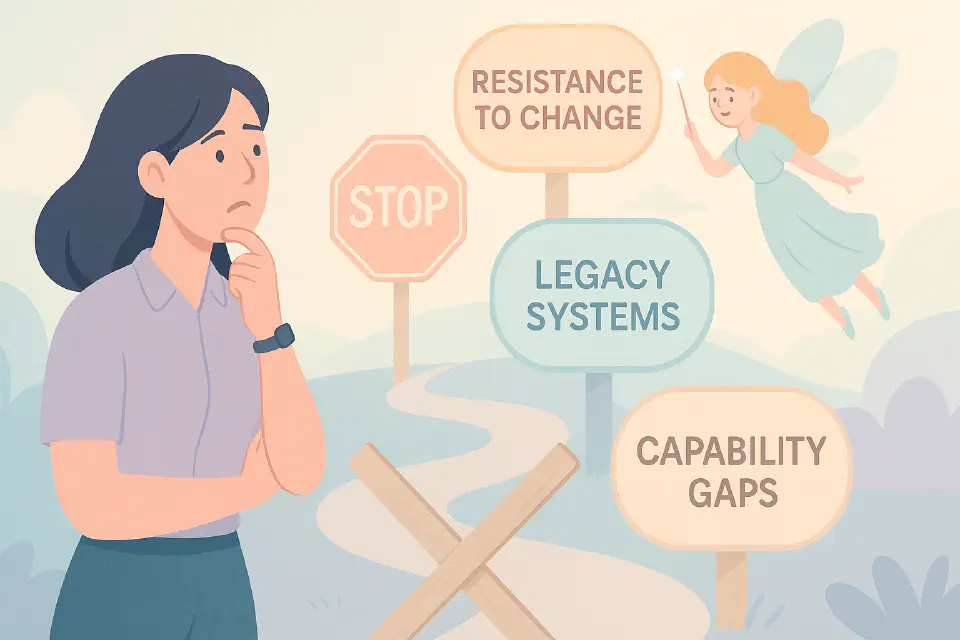
Overcoming Barriers to Digital HR Transformation
Digital HR transformation fails more often from people problems than tech problems. Knowing the blockers is the first step to beating them.
No HR leader sets out to fail at digital transformation—yet many do. According to most global benchmarks, between 60–70% of digital transformation initiatives underdeliver or stall. And while technology may be complex, the biggest barriers are rarely technical. They’re human, organizational, and strategic.
This article explores the most common barriers to digital HR transformation, why they happen, and what HR leaders can do to overcome them proactively.
1. Lack of Strategic Clarity
Many initiatives begin with buzzwords—“AI,” “cloud,” “employee experience”—but lack a clear business case or value hypothesis.
Symptoms:
- Vague vision statements
- Unclear success metrics
- Projects that chase tools instead of solving problems
Solution: Start with strategic intent, link it to business outcomes, and create a roadmap that’s outcome-driven—not system-driven.
2. Weak Leadership Buy-in
CHROs may support transformation, but without full commitment from line leaders, CIOs, CFOs, and the CEO, momentum stalls.
Symptoms:
- Passive approvals without engagement
- Budget friction and delays
- Low visibility at leadership forums
Solution: Build shared ownership through co-design, clear messaging, and regular strategic check-ins—not just updates.
3. Resistance to Change
Digital HR transforms how people work—sometimes in uncomfortable ways. Resistance may be active (pushback) or passive (non-use).
Symptoms:
- “We’ve always done it this way” culture
- Low system adoption
- End-users reverting to manual workarounds
Solution: Apply structured change management with stakeholder mapping, champions networks, and two-way communication.
4. Capability Gaps in HR
HR teams often lack experience with digital design, agile delivery, data interpretation, or user experience strategy.
Symptoms:
- Overreliance on vendors
- Slow execution
- Misalignment between tools and needs
Solution: Invest in capability building across HR roles—digital fluency, agile practices, and tech literacy must become core competencies.
5. Poor Integration with IT and Other Functions
HR can’t transform in a silo. Lack of alignment with IT, Finance, or Operations leads to fragmented efforts and duplicated platforms.
Symptoms:
- Conflicting systems or data definitions
- Missed dependencies
- Shadow IT or workarounds
Solution: Establish joint governance structures, shared backlogs, and aligned architecture planning with enterprise partners.
6. Inflexible Legacy Systems
Outdated systems can be expensive, rigid, and incompatible with new tools or interfaces.
Symptoms:
- Multiple logins, inconsistent UX
- Difficulties in reporting or API access
- Vendor lock-in
Solution: Prioritize modular, composable systems and create a phased decommissioning plan with IT.
7. Lack of Measurable Progress
Without KPIs, dashboards, or OKRs, it’s hard to tell if transformation is working—or justify continued investment.
Symptoms:
- Activity without impact
- Waning stakeholder interest
- Budget cuts mid-cycle
Solution: Define and track metrics like:
- Time-to-value
- User adoption
- NPS and satisfaction
- Process automation levels
- Business outcome linkage
8. Underinvesting in Adoption
Buying the system is easy. Getting people to use it is not.
Symptoms:
- High license counts, low usage
- Training as an afterthought
- Reactive support instead of proactive enablement
Solution: Design adoption into the plan: onboarding, peer coaching, in-app guidance, and clear escalation channels.
9. Treating It Like a Project, Not a Program
Digital transformation isn’t a one-and-done event. It’s a continuous evolution that requires sustained leadership, iteration, and governance.
Symptoms:
- “We’re done” mindset post go-live
- No roadmap beyond initial launch
- Lack of ownership for continuous improvement
Solution: Create a product mindset in HR. Appoint owners, maintain roadmaps, and build backlog discipline.
Final Thought
Digital HR transformation doesn’t fail because people don’t care. It fails because people don’t feel equipped, engaged, or included. By recognizing the common traps—and planning beyond the tech—HR can build transformation that actually transforms.